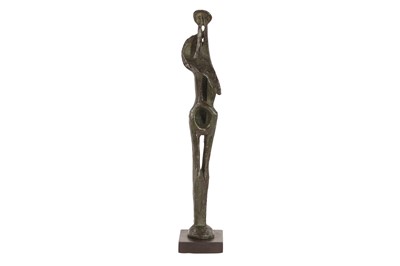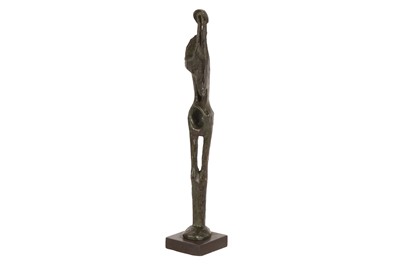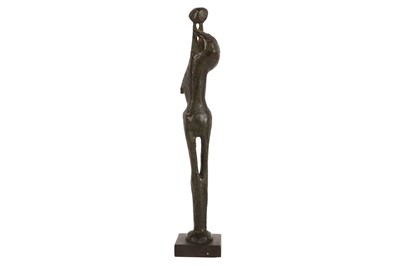29th Mar, 2023 10:00
Modern British & Irish Art
HENRY MOORE, O.M., C.H. (BRITISH, 1898-1986)
HENRY MOORE, O.M., C.H. (BRITISH, 1898-1986)
Standing Figure No. 2
bronze with a green patina on a slate base
artist's cast aside from the edition of 9
27 cm. (10 5/8 in.) high (excluding the slate base)
Conceived in 1952
The present work is the one artist's cast aside from the edition of 9, and was cast by Charles Gaskin of The Art Bronze Foundry, London.
Provenance
The Artist, from whom purchased by the family of the present owner
Literature
Alan Bowness (ed.), Henry Moore, Complete Sculpture, Volume 2, Lund Humphries, London, 1965, p.40, cat.no.318 (ill.b&w, another cast)
We are grateful to The Henry Moore Foundation for their assistance in cataloguing the present lot.
ARR
“A sculptor is a person who is interested in the shape of things, a poet in words, a musician by sounds”
(Henry Moore)
Henry Moore is widely recognised as one of the most celebrated and significant British artists of all time. The artist’s work had a profound effect and impact on the course of art, his influence spanning for generations beyond his longstanding and remarkable career.
Moore grew up in a mining community in Yorkshire, England, and he was surrounded by the physical labour of the miners, as well as the rugged, rocky landscape of the area. As a child, he spent a great deal of time exploring the moors and the surrounding countryside, and he developed a keen eye for the natural shapes and forms of the world around him.
Later, as a student of sculpture, Moore was drawn to the work of ancient civilizations, particularly the art of ancient Egypt and the Aztecs. He was intrigued by the way that these cultures used the human figure as a symbol of power, strength, and spiritual significance.
Moore's interest in the figure continued throughout his career, and he produced a vast body of work that explored the human form in a variety of ways. His sculptures ranged from highly abstracted figures to more naturalistic depictions, and he was particularly interested in the way that the figure could convey a sense of energy and emotion.
The present work was conceived in the same year as Moore was working on his seminal masterpiece Reclining Figure, which would be later installed at UNESCO headquarters in Paris, France.
Overall, Moore's obsession with figures can be seen as a reflection of his deep curiosity about the world around him, as well as his fascination with the human form as a symbol of power, spirituality, and the inherent beauty of nature.
Sold for £20,000
Includes Buyer's Premium
Do you have an item similar to the item above? If so please click the link below to submit a free online valuation request through our website.






